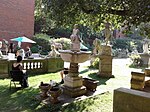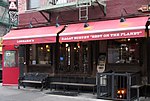Nolita
All Wikipedia neutral point of view disputesItalian-American culture in New York CityLittle Italys in the United StatesNeighborhoods in ManhattanNolita ... and 1 more
Wikipedia neutral point of view disputes from July 2018

Nolita, sometimes written as NoLIta, and deriving from "North of Little Italy" is a neighborhood in the borough of Manhattan in New York City. Nolita is situated in Lower Manhattan, bounded on the north by Houston Street, on the east by the Bowery, on the south roughly by Broome Street, and on the west by Lafayette Street. It lies east of SoHo, south of NoHo, west of the Lower East Side, and north of Little Italy and Chinatown.
Excerpt from the Wikipedia article Nolita (License: CC BY-SA 3.0, Authors, Images).Nolita
Mott Street, New York Manhattan
Geographical coordinates (GPS) Address Nearby Places Show on map
Geographical coordinates (GPS)
| Latitude | Longitude |
|---|---|
| N 40.722542 ° | E -73.9951515 ° |
Address
Mott Street 229
10012 New York, Manhattan
New York, United States
Open on Google Maps





